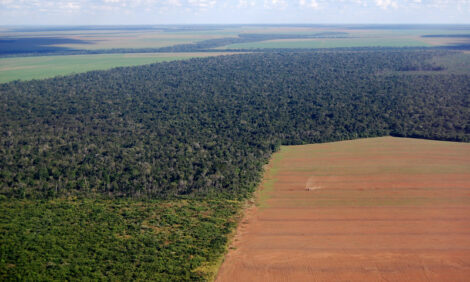



African Swine Fever Threatens All Europe
ANALYSIS - The spread of African Swine Fever from the Caucasus to the east coast of the Crimean peninsula in Ukraine presents an alarming and concerning situation, writes Chris Harris.The latest outbreak, discovered at the end of July and confirmed through PCR tests on samples taken from back yard pigs in the Zaporozhye region, is worrying because it represents not so much a gradual spread of the disease, but a dramatic jump.
The outbreak has occurred 170 kilometres from the Russian border. Until now the disease has been found mainly in the Tver, Ivanovo and Rostov regions to the north of Moscow, Bryansk and Smolensk to the west of Moscow and the Volgograd and Krasnodar regions to the south as well as outbreaks in Georgia.
The furthest the disease had been found outside these regions where it has largely been confined to back yard farms and wild boar populations - although larger pig farms have been infected and have suffered severe losses - has been in the St Petersburg area where the incidence was traced to illegally dumped pig carcases.
The leap across the border is likely to mean that similar illegal transportation of pigs or pig meat products has taken place or that transport has travelled from infected regions without proper biosecurity measures being carried out.
The most concerning aspect of the latest outbreak in Ukraine, where three pigs on a back yard farm dies for the disease and two others were destroyed is that the disease has now spread to another mainland Eastern European country.
The veterinary authorities in Russia have freely admitted that the disease is out of control in the country. Virtually every inspection made on farms in areas that are supposed to have tight biosecurity and sanitary measures in force has found breaches of the regulation.
Prosecutions are common and even officials within the official veterinary agency Rosselkhoznador at local level have been found wanting in their enforcement of control measures.
Earlier this year the Food and Agriculture Organisation of the United Nations' Chief Veterinary Officer Juan Lubroth warned: "African swine fever is fast becoming a global issue.
"It now poses an immediate threat to Europe and beyond. Countries need to be on the alert and to strengthen their preparedness and contingency plans."
Measures recommended for countries by FAO include risk analyses to evaluate the situation and assess potential consequences. These analyses should pave the way for fully-fledged contingency plans and provide the rationale for selecting disease-control strategies.
Over the last year Denmark, Spain, the Czech Republic, Belarus and Croatia have all held simulation exercises to plan out what action to take in the event of an outbreak.
And the concern over the present incidence in Ukraine has placed other EU countries on alert.
The German Agriculture Ministry this week warned: "This epidemic in the Russian Federation and other neighbouring states has been rife for a long time and there is a risk that it might be introduced into the European Union. Already a number of measures at national and EU level have been taken to prevent this.
"At the external borders of the EU increased checks are being carried out and contingency plans to combat animal diseases have been adjusted."
Measures that have been taken include the ban on the import of live pigs and pork products from affected countries into the EU.
However the German Agriculture Ministry has warned that the pathogen can be carried on food such as pork, raw sausages and salami if they are brought in from regions that are at risk and the disease can be passed on in food waste and through the wild boar population.
The Federal Ministry of Food, Agriculture and Consumer Protection warns "Bring no such food from areas affected with the African swine fever."
Following the Ukraine outbreak a report from Dr Helen Roberts for the UK's Department of Agriculture Food and Rural Affairs also warns that its cause is likely to be the movement of pigs, pig products or vehicles.
"The source of disease is not known but if genetic sequencing is carried out and shows the close relationship with the strains in the Caucasus, that will indicate movement of products in all likelihood either by road or by sea into this area. This latest jump is not entirely surprising, but does raise the issue of controlling imports of animal products and instigating swill feeding bans in backyard premises," Dr Roberts reports.
She adds: "We consider that the risk of introduction by legal trade in susceptible livestock or products is negligible as EU rules prohibit imports of such trade from Ukraine. It is therefore important to uphold the ban on swill feeding, to ensure adequate cleansing and disinfection of vehicles returning from infected regions and safe disposal of catering waste.
"Importing meat or meat products (including ham, salami, sausages and other delicacies) from Ukraine as personal imports is illegal and it is important that this control measure is observed.
"As we have previously stated, countries and regions where certain risk factors, such as a high proportion of backyard pig farms, wild boar contact, suitable vector (Argasid tick) populations or practicing swill feeding are at greater risk than those EU MSs with mainly high biosecurity commercial pig farms (such as the UK). Nevertheless, the persistence and geographic spread of ASF makes it a threat to the whole of the EU and it is imperative that control measures are applied effectively and regular exchange of information and expertise is maintained."






